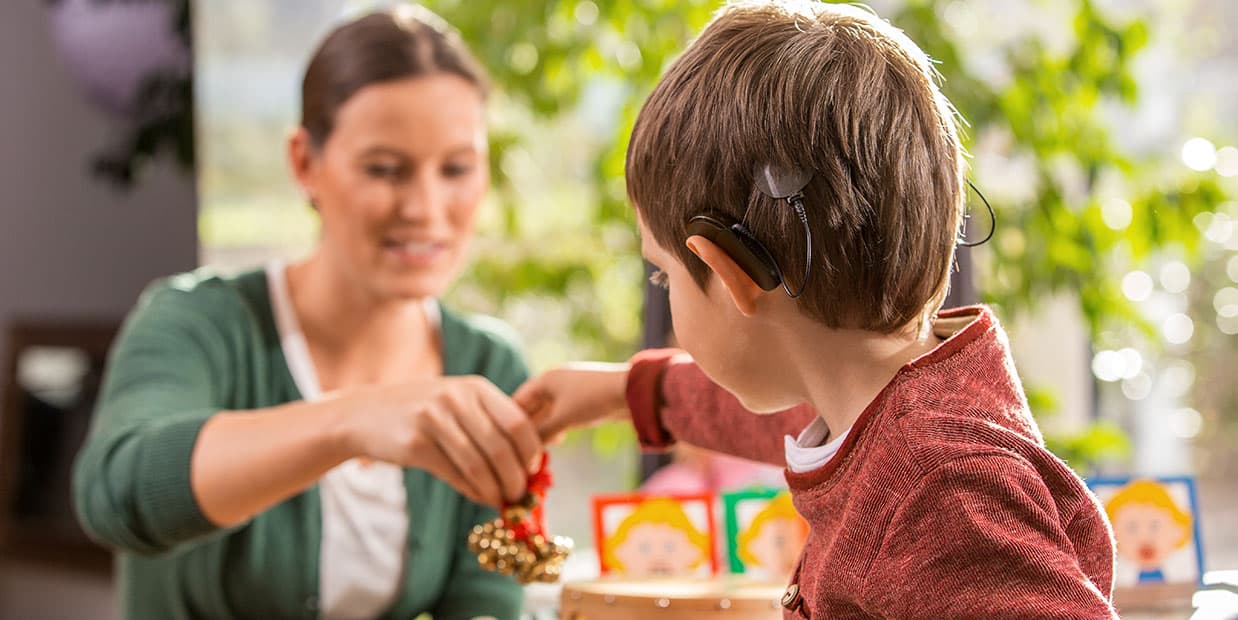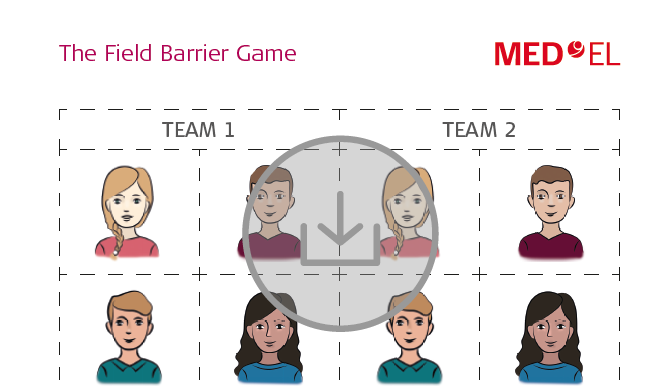MED-EL
Published Jun 14, 2018
5 Ways Barrier Games Can Help Your Child With A Cochlear Implant

Barrier games are a group of games that require communication between two or more players to solve a puzzle or to create matching pictures or scenes. The rules are simple and the games are fun so they are perfect for motivating your child to practise their listening and speaking skills with their cochlear implant, or other hearing device.
You can buy commercial games—the most famous being Battleship, which was originally played using paper and pencil way back in the 1930s. But you can also make your own barrier games at home and target language structures, concepts, or speech sounds that your child is working on in their rehabilitation sessions. To get you started, there’s a free download of “The Field”, a barrier game that you can try yourself at home.
What Kinds Of Barrier Games Are There?
Barrier games can take lots of different forms. Below are two types, which are easy to set up and play at home and give your child lots of opportunities to practise their speaking and listening.
“Matching Scene” Games
This is where each player has an identical set of objects (such as toys or kitchen items) that can be positioned to make a scene. The two players sit opposite each other with a barrier, like a book or folder, in between them so they cannot see each other’s objects.
Each player takes it in turn to select an object and places it somewhere in the scene. Then they instruct the other player: “Put the bear behind the crocodile”, or “Place the teacup on the plate”. Once all the objects are placed in the scene, the barrier is removed to see if the scenes match each other.
“Solve It” Games
In this type of barrier game, both players also have a set of identical items. One player secretly selects an item, and the other player must find out what it is by asking questions: “Is it an animal?”, or “Is it a big object?”
“Solve It” games can also be played by one player positioning an item on a background scene, and the other player asking questions to work out where it is.
Download “The Field” Barrier Game
Want to try out a barrier game with your child? Download “The Field”, and then follow these simple instructions.
- Print out the character cards and two copies of the football field. Cut up the team player cards and ball. You might need to help your child with the cutting.
- The team player cards should be positioned beside each field to start. Use a barrier (a book or folder) to prevent you and your child seeing each other’s field and team player cards.
- Talk about which player you will choose first. You can use a name or description of the player. Then pick up the picture.
- Encourage your child to find the same one after listening to your description.
- Talk about where you will put the player on the field, and encourage your child to follow the directions.
- Then encourage your child to choose a player and talk about where it should go. Place your matching player in the same spot on your field.
- Repeat until all players and the ball are on the field, then lift the barrier and compare fields.
Hint: If your child is at the start of their hearing journey, play the game a few times without the barrier. Then add the barrier to make it more challenging.
How Can Barrier Games Help My Child?
Listening Skills
Barrier games are dependent on listening skills (although there is always a strong temptation to peek around the barrier to check the answers!). For beginner listeners you might like to play the game side by side without a barrier. Talk about the item before you pick it up and again when you talk about where you will put it. As your child becomes more confident in their listening skills and understands the game, add the barrier to make the game more challenging. Try increasing the length and complexity of the directions to develop your child’s auditory memory.
Spoken Language Skills
Barrier games give your child the opportunity to hear the sentence structures modelled by you, before trying it out themselves. This allows them to learn in a natural context and then compare how they sound to the adult sentence model. They also know immediately if their communication was effective, by seeing if the other player could understand their direction or if they required clarification using a question. Try using choice questions to call the child’s attention to the correct sentence structure: “Did you ask, “Does my animal have 4 legs?”, or “Does my animal have 2 legs?””
Speech Skills
You can help your child achieve their speech goals by selecting pictures or identifying function words or verbs containing sounds your child is working on. By modelling the correct speech sound during the game, your child can compare how they sound with your correct model. Try using alliteration to emphasise a particular speech sound: “Put Peppa Pig on the pumpkin”.
Social Skills
The rules of playing barrier games are simple, and they are a good opportunity to talk about the importance of following rules in a game so everyone can play happily. In addition, taking turns and behaving appropriately when you solve it first, or if you don’t solve it, are important social skills. Try making a home-made game using popular characters from a children’s show to provide an opportunity for your child to practise the names, and make it easier to talk with their friends about common interests.
Theory Of Mind Skills
Barrier games help to develop the child’s understanding of perspective—that not everyone can see the same things we see, and if someone cannot see something we can share information to build knowledge. Try to highlight the need to add perceptual information so that the other person can understand the instruction properly: “Put the dog here… Oh wait you can’t see. I will have to tell you more”.
Like this post on using barrier games to help develop your child’s language skills?
MED-EL
Was this article helpful?
Thanks for your feedback.
Sign up for newsletter below for more.
Thanks for your feedback.
Please leave your message below.
Thanks for your message. We will reply as soon as possible.
Send us a message
Field is required
John Doe
Field is required
name@mail.com
Field is required
What do you think?
The content on this website is for general informational purposes only and should not be taken as medical advice. Please contact your doctor or hearing specialist to learn what type of hearing solution is suitable for your specific needs. Not all products, features, or indications shown are approved in all countries.
MED-EL



